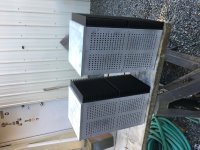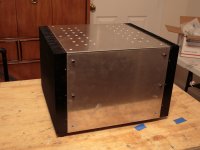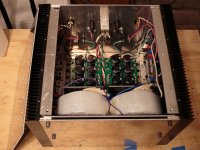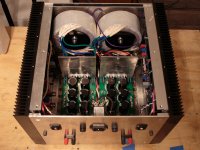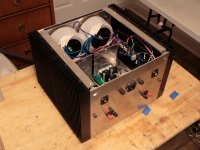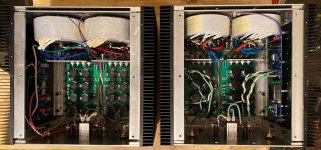Hmmm ... it looks like silkscreen orientation is made for Aussies ...
no
put amp as hat on your head, and you can read it all

Culprit?
Zen.. Although I don't have a smoking gun on the culprit.. It worked power wise all day without issue in my office/shop.. Only when I took it into the kitchen to show my spouse the finished product and plugged it into a kitchen outlet (connected to GFI) it immediately blew. Evidently that happens? Learning new things every day!
I was very careful and even used compressed air to ensure no leftover 'metal bits' anywhere in the case prior to powering it up, so I'm thinking it's something wonky in that kitchen circuit.
I like to use "close-rated fuses", meaning a value so low that it just doesn't blow constantly on power-up. With that, every once in a while, the fuse still blows on power-up ... I guess it comes down to a combination of wall voltage at that particular moment combined with at what point in the AC cycle you happen to press the switch ... as long as it's only every few months, I won't switch to a bigger fuse.
Also, one interesting bit of information: I usually really like the ceramic, sand-filled fuses. However, at the same fuse rating, and both fuses slow-blow (T), I found that this "spurious fuse-blowing" happens way more often with the ceramic fuses than with the glass fuses. So I'm back to the glass fuses ...
SkyPirate, I doubt that your blown fuse has something to do with the GFI.
P.S.: When I buy fuses, I always get a 10-pack of every fuse value I buy
Also, one interesting bit of information: I usually really like the ceramic, sand-filled fuses. However, at the same fuse rating, and both fuses slow-blow (T), I found that this "spurious fuse-blowing" happens way more often with the ceramic fuses than with the glass fuses. So I'm back to the glass fuses ...
SkyPirate, I doubt that your blown fuse has something to do with the GFI.
P.S.: When I buy fuses, I always get a 10-pack of every fuse value I buy
Last edited:
as chede sez - it can be just coincidence, that tired fuse blows after re-location
though - 2A seems little low
if you have 300VA Donut ( for instance) , that calls for 300VA/115Vac= at least 2A5 slow blow, counting on mild nature of ( CL60?) soft start ... even if 3A16 is more likely to serve properly in practice
so, try it with new fuse
though - 2A seems little low
if you have 300VA Donut ( for instance) , that calls for 300VA/115Vac= at least 2A5 slow blow, counting on mild nature of ( CL60?) soft start ... even if 3A16 is more likely to serve properly in practice
so, try it with new fuse
I think the pcb manufacturer was very happy with all those via's.Hmmm ... it looks like silkscreen orientation is made for Aussies ...
as chede sez - it can be just coincidence, that tired fuse blows after re-location
though - 2A seems little low
if you have 300VA Donut ( for instance) , that calls for 300VA/115Vac= at least 2A5 slow blow, counting on mild nature of ( CL60?) soft start ... even if 3A16 is more likely to serve properly in practice
so, try it with new fuse
I like to use "close-rated fuses", meaning a value so low that it just doesn't blow constantly on power-up. With that, every once in a while, the fuse still blows on power-up ... I guess it comes down to a combination of wall voltage at that particular moment combined with at what point in the AC cycle you happen to press the switch ... as long as it's only every few months, I won't switch to a bigger fuse.
Also, one interesting bit of information: I usually really like the ceramic, sand-filled fuses. However, at the same fuse rating, and both fuses slow-blow (T), I found that this "spurious fuse-blowing" happens way more often with the ceramic fuses than with the glass fuses. So I'm back to the glass fuses ...
SkyPirate, I doubt that your blown fuse has something to do with the GFI.
P.S.: When I buy fuses, I always get a 10-pack of every fuse value I buy
Thanks gents.. I have mega pack of fuses on the way. We figured 2A would be a little low, but that's the one that came with the IEC in the store "chassis kit".. I meant to order some additional ones with all of the supplies.. I'll be out of town traveling for a few days anyway, so it's not a big deal! Thanks for the thoughts and suggestions on fuses!
I can't remember who had asked in the other thread re: CL-60 to Euroblock. Apologies.
Slightly related, I suppose.
Short wire soldered to CL-60 legs on each end. One side to Euroblock, one side to your mains earth connection to the chassis. Legs and soldered connections should be heat-shrinked. More experienced folks please chime in, but I believe if you're using wire into the Euroblocks that the strands should not be tinned together, and the CL-60 leg should not ideally be inserted directly into the Euroblock. Terminate the other end with a ring/spade or however you'd like for the chassis connection. If it's neater, and you have enough length to work with, you may just be able to add a termination directly to the leg of the CL-60 for your chassis-side connection.
OR... solder CL-60 to PSU board. Run small wire to chassis. But, I think someone mentioned for that build that you did not want to solder the CL-60 to the PSU board and wanted to use the Euroblock.
Probably lots of cool solutions, but I haven't personally seen that specific configuration either.
Finished AJ
Over a year ago I embarked on a journey to design my own Aleph-J variant for a giant, four-sided heatsink in the style of the Aleph 0 chassis.
Thread: Aleph 0 layout for Aleph J
I got as far as wiring everything P2P and plugging it in - but it was a rat's nest of jumpers, questionable soldering, and new circuits (I also had a P2P capacitance MX that let out some smoke...). I was NOT prepared to troubleshoot my way out of that corner.
After setting that project aside for a bit, I scored more, nicer heatsinks on eBay, and set about making a chassis to fit the UMS pattern.
I ended up building the M2X first. (Link in sig)
With newfound confidence and enough raw material to build another UMS-compatible chassis, I returned to the Aleph J using the store's UMS boards. (Dual mono w/ AS-4220; 28V rails)
I was happy to find that it fired up without a hitch! Makes music. Thankfully, the problem with the last build was my implementation, and not the jfets.
...well, there is one minor hitch. I forgot to jumper the vertical R27, so the bias pot isn't connected to the gates of the current source - the bias is running full steam at about 1.3 A per mosfet. I went ahead and tossed the panels on (as shown) to see how the temperatures worked out - and the mosfet mounting bolts are right at 65 deg C. When I feel like pulling it all apart again, I'll likely solder in the jumpers to bring the bias down a bit, but for now, the temperatures are manageable.
Last picture has the M2X on the right.
Now, I still have those four heatsinks from the original chassis - more room to build!
Over a year ago I embarked on a journey to design my own Aleph-J variant for a giant, four-sided heatsink in the style of the Aleph 0 chassis.
Thread: Aleph 0 layout for Aleph J
I got as far as wiring everything P2P and plugging it in - but it was a rat's nest of jumpers, questionable soldering, and new circuits (I also had a P2P capacitance MX that let out some smoke...). I was NOT prepared to troubleshoot my way out of that corner.
After setting that project aside for a bit, I scored more, nicer heatsinks on eBay, and set about making a chassis to fit the UMS pattern.
I ended up building the M2X first. (Link in sig)
With newfound confidence and enough raw material to build another UMS-compatible chassis, I returned to the Aleph J using the store's UMS boards. (Dual mono w/ AS-4220; 28V rails)
I was happy to find that it fired up without a hitch! Makes music. Thankfully, the problem with the last build was my implementation, and not the jfets.
...well, there is one minor hitch. I forgot to jumper the vertical R27, so the bias pot isn't connected to the gates of the current source - the bias is running full steam at about 1.3 A per mosfet. I went ahead and tossed the panels on (as shown) to see how the temperatures worked out - and the mosfet mounting bolts are right at 65 deg C. When I feel like pulling it all apart again, I'll likely solder in the jumpers to bring the bias down a bit, but for now, the temperatures are manageable.
Last picture has the M2X on the right.
Now, I still have those four heatsinks from the original chassis - more room to build!
Attachments
Last edited:
FWIW, I took delivery of 20x of the 74's from punkydawgs (BL) last week. I ordered them in a panic thinking mine were toast.
Planning on matching them and offering as many pairs as I can up to other DIYers, keep a couple for a project or two (or four?!)
I'd like to build an Aleph J so would be very interested in some of these, if possible.
Is there anything else one can use in place of the 2SJ74s?
I see that the matched quads of 2SJ74s are out of stock at the store. But they have matched quads of LSK170/2SJ74. If I bought two of those, would that give me four 2SJ74s, so enough? Of course, I'd have the extra LSK170s, but I can live with that.
Last edited:
- Home
- Amplifiers
- Pass Labs
- Aleph J illustrated build guide
